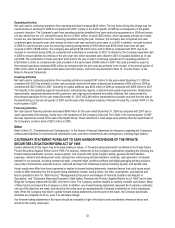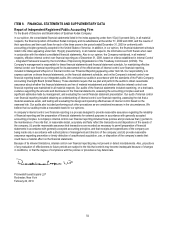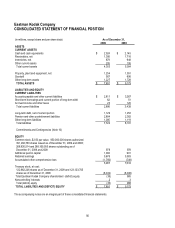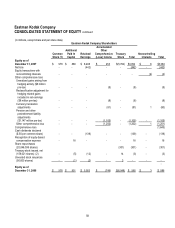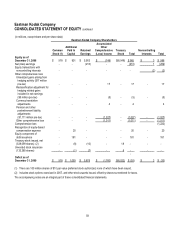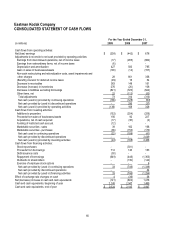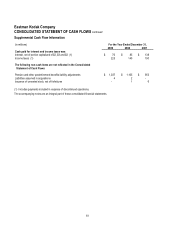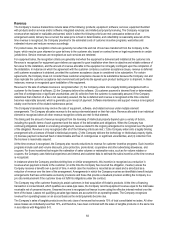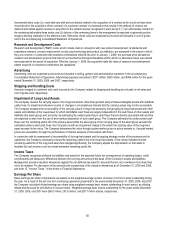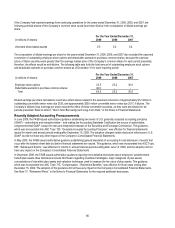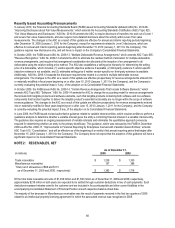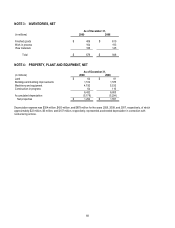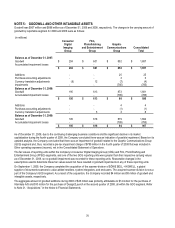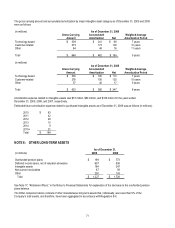Kodak 2009 Annual Report Download - page 64
Download and view the complete annual report
Please find page 64 of the 2009 Kodak annual report below. You can navigate through the pages in the report by either clicking on the pages listed below, or by using the keyword search tool below to find specific information within the annual report. 62
Eastman Kodak Company
NOTES TO FINANCIAL STATEMENTS
NOTE 1: SIGNIFICANT ACCOUNTING POLICIES
Accounting Principles
The consolidated financial statements and accompanying notes are prepared in accordance with accounting principles generally
accepted in the United States of America. The following is a description of the significant accounting policies of Eastman Kodak
Company.
Basis of Consolidation
The consolidated financial statements include the accounts of Eastman Kodak Company, its wholly owned subsidiaries, and its
majority owned subsidiaries (collectively “the Company”). The Company consolidates variable interest entities if the Company has a
controlling financial interest and is determined to be the primary beneficiary of the entity. The Company accounts for investments in
companies over which it has the ability to exercise significant influence, but does not hold a controlling interest, under the equity
method of accounting, and the Company records its proportionate share of income or losses in Other income (charges), net in the
accompanying Consolidated Statements of Operations. The Company accounts for investments in companies over which it does not
have the ability to exercise significant influence under the cost method of accounting. These investments are carried at cost and are
adjusted only for other-than-temporary declines in fair value. The Company has eliminated all significant intercompany accounts and
transactions, and net earnings are reduced by the portion of the net earnings of subsidiaries applicable to minority interests.
The Company has evaluated subsequent events for recognition and disclosure in the financial statements through the date of
issuance, February 22, 2010.
Use of Estimates
The preparation of financial statements in conformity with accounting principles generally accepted in the United States of America
requires management to make estimates and assumptions that affect the reported amounts of assets and liabilities and disclosure of
contingent assets and liabilities at year end, and the reported amounts of revenues and expenses during the reporting period. Actual
results could differ from those estimates.
Change in Estimate
In the first quarter of 2008, the Company performed an updated analysis of expected industry-wide declines in the traditional film and
paper businesses and its useful lives on related assets. Based on additional experience in the secular decline in these product
groups, the Company assessed that overall film demand had declined but at a slower rate than anticipated in 2005, notably in the
motion picture films category, which accounts for a substantial portion of the manufacturing asset utilization in the film business. In
addition, the demand declines in the Company’s paper business have not been as extensive as assumed in 2005. As a result, the
Company revised the useful lives of certain existing production machinery and equipment, and manufacturing-related buildings
effective January 1, 2008. These assets, which were previously set to fully depreciate by mid-2010, are now being depreciated with
estimated useful lives ending from 2011 to 2015. The change in useful lives reflects the Company’s estimate of future periods to be
benefited from the use of the property, plant, and equipment. As a result of these changes, for full year 2008 the Company reduced
depreciation expense by approximately $107 million, of which approximately $95 million benefited loss from continuing operations
before income taxes. The net impact of the change in estimate to loss from continuing operations for the year ended December 31,
2008 was a decreased loss of $93 million, or $.33 on a fully-diluted loss per share basis.
Foreign Currency
For most subsidiaries and branches outside the U.S., the local currency is the functional currency. The financial statements of these
subsidiaries and branches are translated into U.S. dollars as follows: assets and liabilities at year-end exchange rates; income,
expenses and cash flows at average exchange rates; and shareholders’ equity at historical exchange rates. For those subsidiaries
for which the local currency is the functional currency, the resulting translation adjustment is recorded as a component of
Accumulated other comprehensive (loss) income in the accompanying Consolidated Statement of Financial Position. Translation
adjustments related to investments that are permanent in nature are not tax-effected.
For certain other subsidiaries and branches, operations are conducted primarily in U.S. dollars, which is therefore the functional
currency. Monetary assets and liabilities of these foreign subsidiaries and branches, which are recorded in local currency, are
remeasured at year-end exchange rates, while the related revenue, expense, and gain and loss accounts, which are recorded in
local currency, are remeasured at average exchange rates. Non-monetary assets and liabilities, and the related revenue, expense,
and gain and loss accounts, are remeasured at historical rates. Adjustments that result from the remeasurement of the assets and
liabilities of these subsidiaries are included in Net (loss) earnings in the accompanying Consolidated Statement of Operations.


